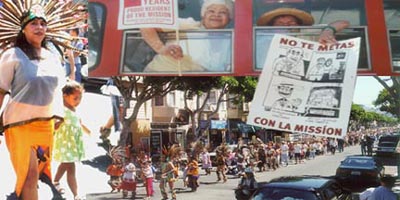|
by Kaponda and Tom McKay
The Danzates moved about like visible spirits as their blessings
poured upon the four infants whom they shielded within the fringes of
their ceremonial dance. Dressed in motley costumes that symbolized the
vivacious culture of the Latino community, the Danzates exhibited an emotional
performance which forebode the dawning of a new vanguard in the Mission
District.
The focus of the movement is aimed at the prevention of rapid displacement
of artists, workers, residents and merchants in the Mission by unscrupulous
real estate developers. The Mission District is the latest staging area
for highly technical venture capitalists and fledgling business enterprises
whose start-ups neither guarantee a long-term marriage with the Mission,
nor bring the kind of stability necessary for their continued survival
in the Mission.
"If you look at the NASDAQ, they [high-tech industries] are not even
that economically viable anymore. So, are we going to lay waste neighborhoods
for dot.com space and in five years the neighborhoods will be empty and
rotten and the damage will have been done and very hard to reclaim?" asked
Board of Supervisor President Tom Ammiano during an interview with my
editor, Lisa Gray-Garcia and I, as we participated in what was dubbed,
"Caminata," on Saturday, August 12, 2000.
Mi Rancho Market represented the kind of economic viability that Supervisor
Ammiano talked about. Located on 20th and Shotwell streets for over 40
years, it embodied the spirit of the Mission. It was one of the sites
designated by the Mission Anti-Displacement Coalition as an illustration
of the kinds of atrocities that are being perpetrated by developers in
the Mission. Ten condominiums will be constructed at the former site of
Mi Rancho Market to provide housing for the future employees of the brick
building on the corner -- the brick building which consists of fifty percent
of high-tech office space!
"I just want all of this to translate in November to a passage of Proposition
L, which will start to put the brakes on the displacement that has been
happening, particularly in the Mission District, Potreo Hill, South of
Market and Bayview. The Mayor did a really sneaky thing. Two minutes before
the deadline, he put something on the ballot that had a lot of loopholes
in it, particularly around live-work. He also tried a divide-and-conquer
strategy, and we are too smart for that. He left out a lot of neighborhoods
that we want to protect as well," Supervisor Ammiano continued to speak
as he walked under the warmth of the buttery sphere in the brilliance
of the sapphire upper atmosphere.
Proposition L is the instrument that all of the people who participated
in the Caminata on Saturday, and most of the residents and merchants of
the Mission District hope will be the slayer of the huge dot.com dragons
that are devouring huge chunks of real estate in their neighborhoods.
This preliminary law would, among other things, amend the Planning Code's
Priority Policies to link commercial development to transit capacity and
traffic improvements, and discourage displacement of community services
and arts activities. In addition, it would redefine "office space" to
include multimedia and computer-based services such as software development,
web design, and electronic commerce. The redefinition of "office space"
is an essential element of Proposition L, since most developers take advantage
of the code's current broad and ambiguous description to construct high-tech
industries in the Mission.
The event was organized by members of the Mission Anti-Displacement Coalition
(MAC), the political, economic and social watchdog formed to curb the
flight from the Mission and the Hispanic diaspora throughout the Bay Area.
The rate of occurrence of gentrification in the Mission is astounding.
Within the past three years, there have been over 1,000 evictions. The
severity of this rate of eviction was summarized by Bill Sorro of Mission
SRO Collaborative, a component of MAC. According to Bill, "The people
who have been here for a long time are tired of being pushed out. Not
one Latino person has even come down the steps on which I am currently
sitting while you interview me. The only people who have come out of this
building, down these steps, have been young, white, hip people. I'll bet
you a dollar to a doughnut that these people have displaced our Latino
people."
His mustache sprinkled with gray, the middle-aged activist sat on the
stairs of an adjoining apartment complex with one eye on the rhythmic
performance of the Danzates as he resumed his expressions of fervor. This
event today is a culmination of years of frustration in this community.
This is the barrio. This is the barrio of the Mission District.
It has a soul that is unlike any other part of the city that is still
in tact....The barrio here is a very special working-class neighborhood."
A Mission resident of six years, a troublemaker and former member of
the Coalition on Homelessness, Stefan Goldstone became hot under the collar
as he expounded his first-person account of the consequences that the
greed of developers have had on his place of birth. According to Stefan,
"The interests of the people are not being served by the policies of the
city. The culture of the neighborhood and ability for low-income people
to stay here are being erased by the invasion of yuppies....I know a few
people who have directly been evicted from their houses as a result of
the dot.com invasion. There is also an indirect affect of this phenomenon.
My parents and best friend do not live here anymore. They were not necessarily
evicted directly, but the influx of the dot.coms and business interests
over the interests of people [like them] have made it so that their rents
had become so high and the quality of life so low that they were forced
to move to Oakland, Antioch and Pacifica -- all over the Bay Area. This
is neither fair nor right. People should have a right to live in
their communities with their friends where they were born...."
As the walk to defend the right to live in the Mission and to prevent
greed-driven speculators from shattering neighborhoods was about to began,
I asked Christian Parenti, also a resident of the Mission District, to
give tell me what he thinks of the Caminita. "This is a much needed public
protest against the evisceration of our home -- the Mission. It will send
a message to the Planning Department and the City that they can no longer
discard the law by working hand-in-glove with what is really totally illegal
development. Calling the development R&D to circumvent restriction
on office space, and the use of eviction of all the nonprofit tenants
out of the Bayview Bank, are examples of illegal development that the
City is facilitating. The City is not passively standing, but is working
hand-in-glove with dot.com industries and developers. It feels like a
sought of slow, subtle rape of a community."
|




